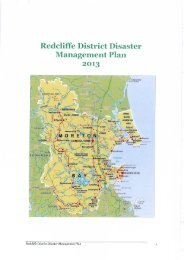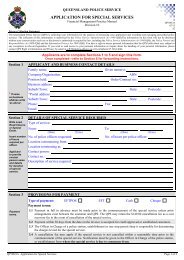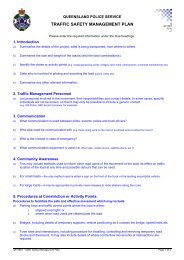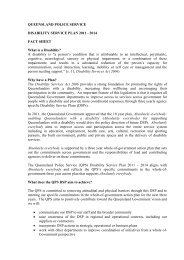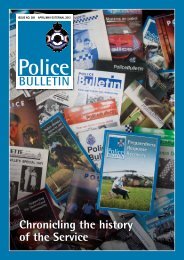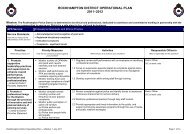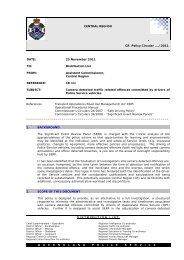Credit card & EFTPOS fraud - Queensland Police Service
Credit card & EFTPOS fraud - Queensland Police Service
Credit card & EFTPOS fraud - Queensland Police Service
You also want an ePaper? Increase the reach of your titles
YUMPU automatically turns print PDFs into web optimized ePapers that Google loves.
What’s Fraud?<br />
Fraud is behaviour that’s deceptive, dishonest,<br />
corrupt or unethical.<br />
For a <strong>fraud</strong> to exist there needs to be an offender, a<br />
victim and an absence of control or safeguards.<br />
Here in <strong>Queensland</strong>, the laws on <strong>fraud</strong> involve<br />
dishonesty in any of these situations:<br />
- obtaining property belonging to someone else<br />
- applying someone else’s property to one’s own<br />
use<br />
- causing a detriment to another person or entity<br />
- gaining a benefit or advantage for any person; and<br />
- inducing or causing any person to deliver property<br />
to another person<br />
Fraudulent activity in the workplace often results in<br />
the loss of revenue and property, while increasing<br />
operational costs and service charges. It can also<br />
mean obligations to employees, customers,<br />
suppliers or contractors can’t be met.<br />
The knock-on effect for businesses may:<br />
- damage credibility<br />
- compromise confidentiality<br />
- result in public criticism<br />
Common <strong>fraud</strong>s include using false<br />
- identities<br />
- cheques<br />
- credit and <strong>EFTPOS</strong> <strong>card</strong>s<br />
Fraud Risks and Prevention Measures<br />
With the rapid advancements in technology, <strong>fraud</strong>s<br />
are becoming more sophisticated, widespread and<br />
complex. As a result, stamping out <strong>fraud</strong>ulent<br />
practices becomes a huge challenge and requires<br />
extra vigilance on the part of businesses and<br />
individuals<br />
<strong>Credit</strong> Cards and<br />
<strong>EFTPOS</strong><br />
As we evolve into a cashless society with more and<br />
more businesses and individuals using credit <strong>card</strong>s<br />
and electronic banking, the likelihood of becoming a<br />
victim of <strong>fraud</strong> increases.<br />
Criminals have embraced modern technology to<br />
pursue their dishonest activities. Methods used<br />
include credit <strong>card</strong> skimming, false and stolen<br />
identities and taking advantage of ineffective<br />
security systems to obtain Internet banking<br />
passwords and account particulars.<br />
Why does it happen?<br />
The main risks with credit and debit <strong>card</strong>s involve<br />
Theft<br />
Cards may be intercepted in the post, sent or<br />
delivered to the wrong address<br />
Counterfeit <strong>card</strong>s<br />
False identities may be used to produce counterfeit<br />
<strong>card</strong>s<br />
Fraudulent transactions<br />
Stolen <strong>card</strong>s may be used to purchase goods or<br />
obtain cash advances or stolen credit <strong>card</strong> details<br />
may be used for telephone orders.<br />
What can you do?<br />
To avoid becoming a victim of credit and debit <strong>card</strong><br />
<strong>fraud</strong>, you can:<br />
- arrange to personally collect new or replacement<br />
<strong>card</strong>s from your financial institution<br />
- ensure you keep your credit <strong>card</strong> and debit <strong>card</strong><br />
secure<br />
- never keep your PIN number with your <strong>card</strong><br />
- when using an ATM, be aware of anyone standing<br />
close by or watching over you<br />
- take steps to conceal the keypad when you enter<br />
your PIN<br />
- when paying for goods or services at a point of sale,<br />
don’t allow your debit or credit <strong>card</strong> out of your sight<br />
When accepting payment by <strong>card</strong>, always check the<br />
following details:<br />
- Account Number - the embossing should be clear<br />
and uniform in size and spacing and match the<br />
number on the back of the <strong>card</strong>. The last 4 digits of<br />
the embossed number on the front of the <strong>card</strong><br />
should be the same as the reverse indent italic<br />
number on the signature panel on the back of the<br />
<strong>card</strong>. This number is also printed on the sales<br />
receipt or displayed on the terminal. Printed<br />
Number – a 4 digit number may be pre-printed on<br />
the <strong>card</strong> and must match the first 4 digits of the<br />
embossed account number.<br />
- Valid Date - all <strong>card</strong>s have a “Valid To” date, and<br />
some <strong>card</strong>s also have a “Valid From” date. Make<br />
sure the <strong>card</strong> is current.<br />
Master<strong>card</strong>, Bank<strong>card</strong> and Visa<br />
- Security Character – Master<strong>card</strong> has “MC”<br />
embossed on the <strong>card</strong>, Visa has a “V” and<br />
Bank<strong>card</strong> has a “B”<br />
- Hologram –they all include holograms that should<br />
appear three dimensional and move when the <strong>card</strong><br />
is tilted<br />
- Signature Panel – the words Master<strong>card</strong>, Visa or<br />
Bank<strong>card</strong> should be printed at a 45 degree angle<br />
on a tamper-proof signature panel.<br />
- Validation Code - There should also be a three digit<br />
<strong>card</strong> validation code printed on the panel after the<br />
last 4 digits of the <strong>card</strong> number.<br />
Businesses<br />
It’s just common sense!<br />
When accepting payment by credit or debit <strong>card</strong>,<br />
always check for any visible signs of damage to the<br />
<strong>card</strong>.





